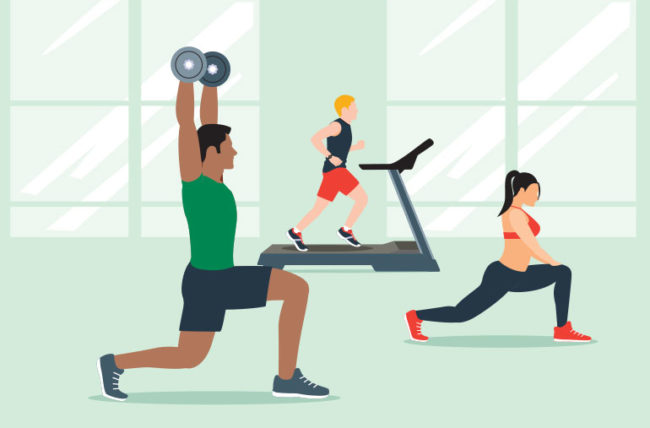The purpose of physical exercise is not just to prove to ourselves that we are able to defy the aging process, look good, or prevent a heart attack. Exercise also enhances our capacity to digest food and eliminate physical and emotional impurities. Furthermore, it increases firmness and suppleness, as well as our ability to deal with stressful situations. The lymphatic system, especially, which drains toxic and noxious substances from the connective tissues of the organs and muscles, depends on the daily movement of all the parts of the body. Unlike the blood, which has a heart to circulate it around the body, the lymph fluid has no such direct pumping device to do the same. The lymphatic system heavily relies on the breathing mechanism and how well we use it. When the muscle responsible for the breathing action of the lungs (diaphragm) extends into the abdomen, it exerts great pressure on the intestinal lymph vessels, thereby squeezing their contents. This forces the lymph to move through the lymph ducts, such as the thoracic duct. Thus, each inhalation and exhalation acts as an indirect pump for the lymphatic system. Shallow breathing that results from a sedentary lifestyle (and intestinal congestion) has a detrimental effect on proper lymph drainage. Exercise can greatly improve lymphatic functions and thereby prevent a multitude of diseases.
Physical exercise is a great immune-stimulant if done in moderation, and it also improves neuromuscular integration in all age groups. Its effect of boosting self-confidence and self-esteem stems, to some extent, from the improved oxygen supply to the cells and the resulting well-being in all parts of the body and mind. Exercise is an excellent means of increasing happiness in life, especially if it involves challenges that require creativity.
The conventional approach to exercise promotes the belief that a good workout takes you to the limits of your endurance, leaving you exhausted and tired. This is not true. Exercise that exhausts your body is an indirect act of violence that the body perceives as a kind of punishment for not performing well enough. The pain that shows in people’s faces when they struggle through a tough workout program is an indication that the body is suffering from overexertion. This sort of exercise defeats its purpose. Any form of strong physical exertion upsets Vata and causes the secretion of abnormal amounts of stress hormones such as adrenaline; this leaves the body restless and shaky. The body, thus depleted of energy, is unable to do the repair work that arises from the demanding workout, leaving the cardiovascular system weak and vulnerable to other stress factors.
Post-exercise exhaustion is a serious cause of illness that affects many unsuspecting people who think they are doing themselves a favor by pushing their bodies to the limit. In the excitement of competitive sports, you may not be aware at first how strenuously you are exerting yourself, but once the adrenaline rush is over, the side effects start kicking in. Besides exhaustion and possible injury, professional athletes are more likely to suffer from a deficient immune system, which makes the body prone to infections and other ailments. For this reason, athletes consume a much larger quantity of prescribed drugs than the average person does. The thymus gland, which activates lymphocytes and controls energy supplies, may actually shrink in size and leave the body weak and debilitated as a direct result of over conditioning the body and stressing the mind.
Exercise According to the Doshas:
Exercise is best done according to one’s capacity and psycho-physiological body type. A Vata type, who has the lowest capacity for exercise, benefits mostly from such easy ways of keeping fit as walking, dancing, bicycling, taking short hikes, balancing and stretching. Vatas generally do well with Yoga, Tai Chi, and Chi Kung. Since Vata types experience energy in bursts, they should be particularly careful not to overexert themselves. When their energy suddenly drops, they can feel depleted for a long time afterward. This often results in depression.
Pitta types, being competitive by nature, are equipped with more drive and energy than Vatas. They generally are not satisfied with the more ordinary forms of working out. To achieve physical satisfaction, they need a more goal-oriented exercise program. However, they also do not have boundless energy and are better off exercising in moderation.Pittas feel challenged by hiking in the mountains, skiing, jogging, swimming, playing tennis or engaging in other sports that generate in them a sense of achievement.
In sports, you can easily recognize the unbalanced Pitta types. They are often bad losers and may get angry if they feel they are ‘not good enough’. Pittas who get angry while performing should look for a less competitive exercise program to increase their level of satisfaction. Since excessive heat is a sign of unbalanced Pitta, swimming, which has a cooling influence, is one of the best forms of exercise for them. A walk in the cool forest is another excellent way to pacify an unbalanced Pitta type.
Kapha types are the ideal candidates for a good or moderately heavy workout. Weight training, running, rowing, some aerobics, long distance bicycling, dancing for a long time, playing football, basketball and tennis are all very suitable for a Kapha. The Kapha type’s steady energy gives him the necessary endurance and stamina to last through long competitive games without feeling tired. Exercise will clear out any excessive Kapha congestion, remove excessive water and fat, and improve general circulation. This will leave him feeling refreshed and buoyant afterward.


